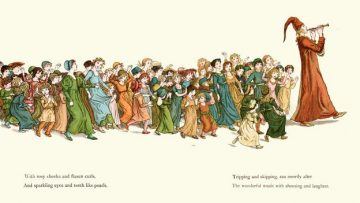Raphael Kadushin in BBC:
 The tale in fact has survived for a very long time. Originating as medieval folklore, the story inspired a Goethe verse, Der Rattenfänger; a Grimm Brothers’ legend, The Children of Hamelin; and one of Robert Browning’s best-known poems, The Pied Piper of Hamelin. And although each writer tinkered with the story, the basics remained the same: the Piper was hired by Hamelin to rid the town of its plague of rats. Trailing after the hypnotic notes of the rat-catcher’s magical flute, the rodents politely filed through the city gates to their presumed doom.
The tale in fact has survived for a very long time. Originating as medieval folklore, the story inspired a Goethe verse, Der Rattenfänger; a Grimm Brothers’ legend, The Children of Hamelin; and one of Robert Browning’s best-known poems, The Pied Piper of Hamelin. And although each writer tinkered with the story, the basics remained the same: the Piper was hired by Hamelin to rid the town of its plague of rats. Trailing after the hypnotic notes of the rat-catcher’s magical flute, the rodents politely filed through the city gates to their presumed doom.
They weren’t the only ones lured by his music, though. When the town refused to pay the Piper for his service, the saviour turned into a more satanic seducer and came for Hamelin’s children. Entranced by the notes of his flute, the transfixed boys and girls followed the Piper out of town and simply vanished.
While the tale has endured, so has Hamelin itself, which still looks as though it belongs in a fairy tale. Boyer’s tour leads visitors past rows of half-timbered houses. There are 16th Century burgher manors encrusted with Gothic gables and scrollwork, and flamboyant wedding cake buildings offering prime examples of the local Weser-Renaissance architecture, all leering gargoyles and brightly coloured polychrome wood carvings. However, all this is merely background for the town’s real cottage industry, which cashes in on all things Piper. The local restaurants plate a “rat tail” signature dish made from thinly sliced pork, and the bakeries do a brisk business in rodent-shaped breads and cakes. The Hameln Museum offers a sound and light Pied Piper re-enactment; local actors put on an open-air Pied Piper play during summer; and the souvenir shops hawk their own rat-inspired memorabilia. You can go home, if you wish, loaded down with Pied Piper T-shirts, fridge magnets, mugs and flutes.
More here.
